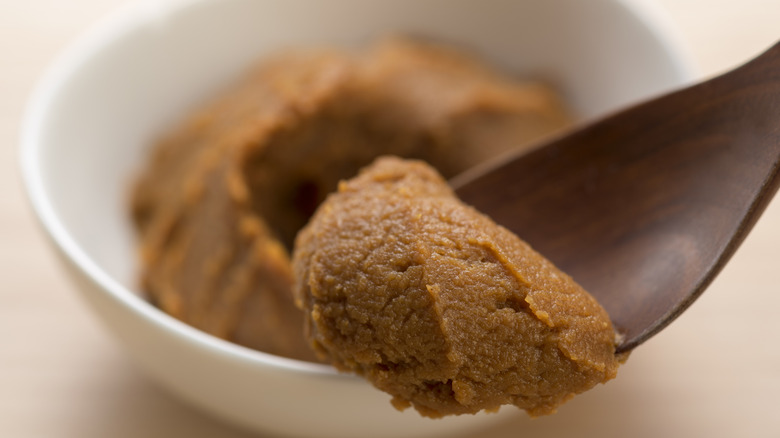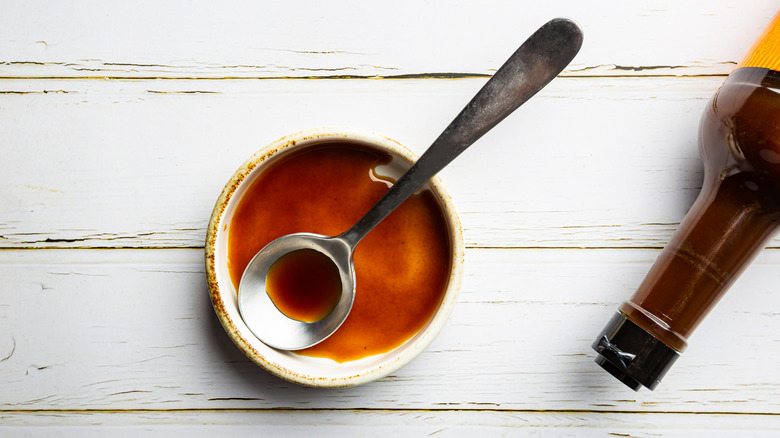6 Ingredients To Avoid For Gluten-Free Salad Dressings
We may receive a commission on purchases made from links.
In theory, as long as you're avoiding foods like bread, pasta, and cake, it should be easy enough to stick to a gluten free diet Meat, vegetables, and dairy in their natural state are all gluten free, but the reality is that so many foods contain hidden sources of gluten — it's the seasonings and sauces you add to your food that often require the most caution. Take a classic Caesar salad: You'll know to skip the croutons (or opt for a gluten-free version made from polenta), but the danger for celiacs comes with the dressing, which can contain multiple sources of gluten, even if you make it at home.
Although the FDA requires that sources of gluten are clearly labeled on ingredient lists, it never hurts to be informed when it comes to allergens. When making salad dressings at home, it's easy to get carried away by adding a dash of all kinds of ingredients, so this list will help you know what should be checked and what can safely be included in your flavor salad.
Malt vinegar
All vinegars are made by fermenting some kind of fruit, grain, or alcohol, and it's this source material that determines its gluten free status. Apple cider vinegar for example, is made from fermented apple juice, making it gluten free. However, malt vinegar is made from barley, which is a red flag for celiacs.
Avoiding this at home is as simple as using other types of vinegar, like balsamic or red wine vinegar. For store-bought dressings, you'll need to check the label for malt vinegar, malt syrup, and malt extract. In the U.S., products specifically labelled as gluten free are no longer allowed to contain any kind of malt ingredient, even if it's been tested for traces of gluten, but according to Gluten Free Watchdog, this isn't always complied with. The good news is that some of our favorite dressings, both gourmet and everyday, are free of malt vinegar and other gluten containing ingredients, including Ken's Steakhouse Italian Dressing.
Soy sauce
Soy sauce is an ingredient that can trip people up, with the misconception that it is made only of soy and salt and it's cheaper brands that will add wheat as a filler. The truth is that wheat performs an essential part of the fermentation process, and traditionally made types of soy sauce will always include either wheat or barley. This applies to light soy sauce, dark soy sauce, and Japanese shoyu.
When making something like this colorful toasted sesame noodle salad at home, tamari is often suggested as the best gluten-free substitute. It's a Japanese soy sauce that's usually made without the use of grains, but be aware that some brands may use a small amount of wheat in the preparation. Alternatively, buy a soy sauce that's certified gluten free. This one from Kikkoman uses rice instead of wheat for fermentation. When buying dressings that include soy sauce, you'll need to check if it's made from wheat — which the FDA requires to be explicitly stated in the ingredients list.
Mustard
When it comes to whipping up a quick salad dressing at home, a spoonful of Dijon with some oil and vinegar is just about the easiest thing you can create. Mustard, of course, is the backbone of a honey mustard dressing and can also show up in some recipes for ranch and Caesar salad dressing. While mustard seeds (and mustard powder) are naturally gluten free, gluten can make its way into mustard in a couple of ways.
All types of mustard rely on vinegar as a vehicle for the mustard powder as well as it's tangy flavor. Depending on the brand, this can mean malt vinegar. It's common for commercially made mustards to add ingredients such as wheat as a thickener, which is another sneaky entry for gluten. There are plenty of good gluten-free mustards, including French's Chardonnay Mustard, and gluten-free mustard dressings, like Whole Foods Organic Honey Mustard.
Blue cheese
This is probably going to be the biggest surprise on the list. After all, dairy is generally considered one of the safe foods for celiacs. The cheese part here isn't really the problem, it's the "blue," the mold that runs the through the cheese and gives it a signature strong flavor. Before being added to the cheese, this mold starts life growing on bread or other cultures that contain gluten. According to the National Celiac Association, the resulting cheese won't contain more than the safe levels of gluten, but it continues to be a source of debate.
Cheesemakers now have the option to use a lab-created liquid version of the mold that hasn't been grown on bread, so there are plenty of cheeses that have never been in contact with gluten if you want to make your own blue cheese dressing at home. For store-bought dressings, Lighthouse Original Blue Cheese and Briannas Home Style Creamy Blue Cheese are labeled gluten free.
Miso paste
Miso paste is another ingredient that, in theory, could be gluten free, but you can't simply make that assumption. The most basic recipe calls for fermenting soybeans, salt, and a fungus known as koji. Like the mold on blue cheese, koji needs something to grow on and, in this case, it's grains. Rice is the most common (and gluten free), but barley is also used, which is the one to look out for.
A well-labelled bottle of dressing such as this one from Marukome Yuzu Miso Dressing will break down the ingredients into their separate components, but if it's only listed as miso paste, you'll need to seek out certified gluten-free options to be on the safe side. This miso vinaigrette from California Olive Ranch attains gluten free status by using a rice-based miso and tamari without wheat. If you want to make this creamy two-ingredient dressing to elevate your salads, try this Hikori Organic White Miso.
Worcestershire sauce
You don't need to know how to pronounce it to know what a great addition Worcestershire sauce can be to a dressing, packing a powerful umami punch. Made famous by a funky failure by Lea & Perrins U.K., the traditional recipe uses malt vinegar, which comes from barley. However, the version produced for the U.S. market is made from white vinegar, despite being from the same brand. So you'll have to pay attention to the label for both the ingredients and country of origin — those made in Canada and the U.K. still use malt vinegar.
Although Lea & Perrins is the best known, the name is not trademarked, so you will find Worcestershire sauce made by other brands — not all of which are gluten free. Worcestershire sauce is a traditional ingredient in Caesar dressings, though not all bottled Caesar salad brands stick to this recipe. Newman's Own Creamy Caesar salad dressing includes a Worcestershire sauce made from distilled vinegar and is labeled gluten free.






